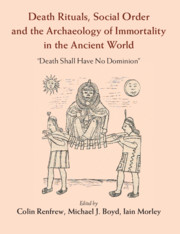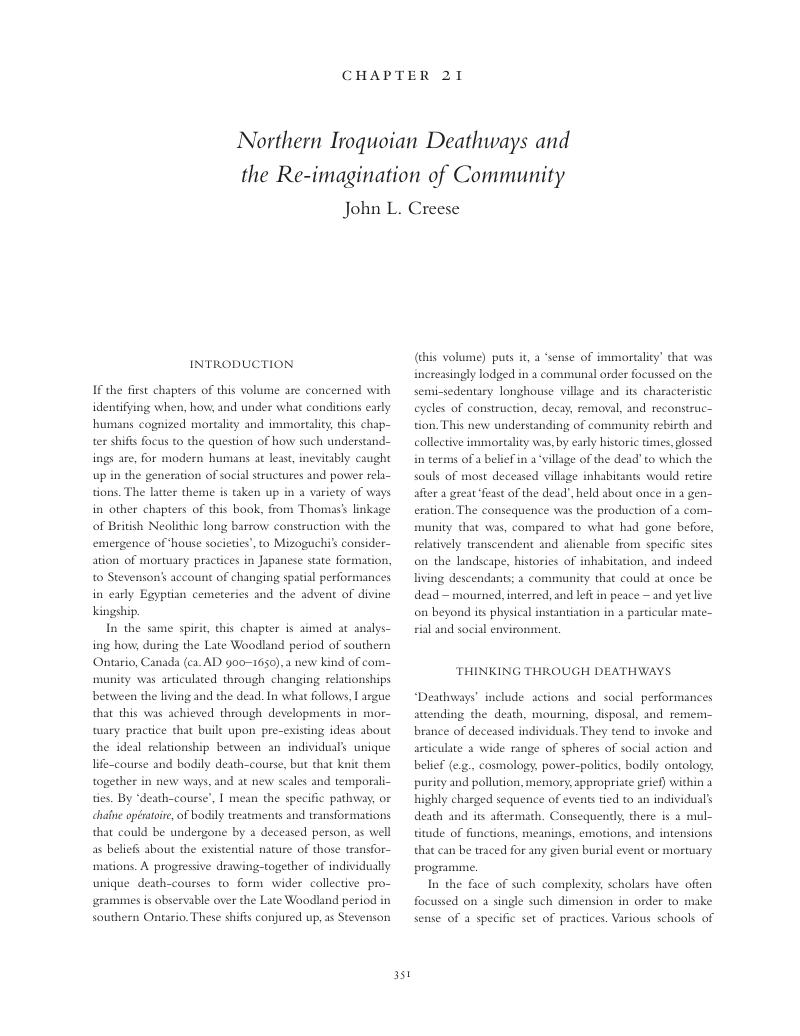 Death Rituals, Social Order and the Archaeology of Immortality in the Ancient World
Death Rituals, Social Order and the Archaeology of Immortality in the Ancient World Book contents
- Death Rituals, Social Order and the Archaeology of Immortality in the Ancient World
- Frontispiece
- Death Rituals, Social Order and the Archaeology of Immortality in the Ancient World
- Copyright page
- Dedication
- Contents
- Illustrations
- Tables
- Contributors
- Preface
- Chapter 1 ‘The Unanswered Question’: Investigating Early Conceptualisations of Death
- Part I Intimations of Mortality
- Part II Mortality and the Foundations of Human Society: Sedentism and the Collective
- Part III Constructing the Ancestors
- Part IV Death, Hierarchy, and the Social Order
- Part V Materiality and Memory
- Part VI Intimations of Immortality: Glimpsing Other Worlds
- Chapter 21 Northern Iroquoian Deathways and the Re-imagination of Community
- Chapter 22 Locating a Sense of Immortality in Early Egyptian Cemeteries
- Chapter 23 Buddhist and Non-Buddhist Mortuary Traditions in Ancient India: Stūpas, Relics, and the Archaeological Landscape
- Chapter 24 Killing Mummies: On Inka Epistemology and Imperial Power
- Part VII Responses and Reactions: Concluding Thoughts
- Index
- References
Chapter 21 - Northern Iroquoian Deathways and the Re-imagination of Community
from Part VI - Intimations of Immortality: Glimpsing Other Worlds
Published online by Cambridge University Press: 05 November 2015
- Death Rituals, Social Order and the Archaeology of Immortality in the Ancient World
- Frontispiece
- Death Rituals, Social Order and the Archaeology of Immortality in the Ancient World
- Copyright page
- Dedication
- Contents
- Illustrations
- Tables
- Contributors
- Preface
- Chapter 1 ‘The Unanswered Question’: Investigating Early Conceptualisations of Death
- Part I Intimations of Mortality
- Part II Mortality and the Foundations of Human Society: Sedentism and the Collective
- Part III Constructing the Ancestors
- Part IV Death, Hierarchy, and the Social Order
- Part V Materiality and Memory
- Part VI Intimations of Immortality: Glimpsing Other Worlds
- Chapter 21 Northern Iroquoian Deathways and the Re-imagination of Community
- Chapter 22 Locating a Sense of Immortality in Early Egyptian Cemeteries
- Chapter 23 Buddhist and Non-Buddhist Mortuary Traditions in Ancient India: Stūpas, Relics, and the Archaeological Landscape
- Chapter 24 Killing Mummies: On Inka Epistemology and Imperial Power
- Part VII Responses and Reactions: Concluding Thoughts
- Index
- References
Summary

- Type
- Chapter
- Information
- Death Rituals, Social Order and the Archaeology of Immortality in the Ancient World'Death Shall Have No Dominion', pp. 351 - 370Publisher: Cambridge University PressPrint publication year: 2015
References
- 1
- Cited by


